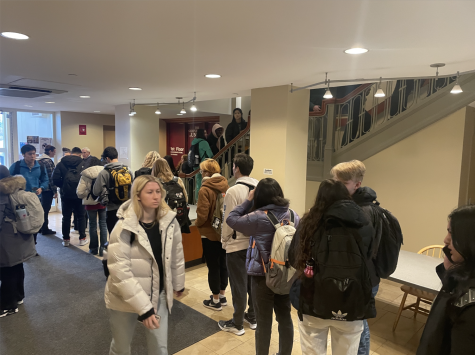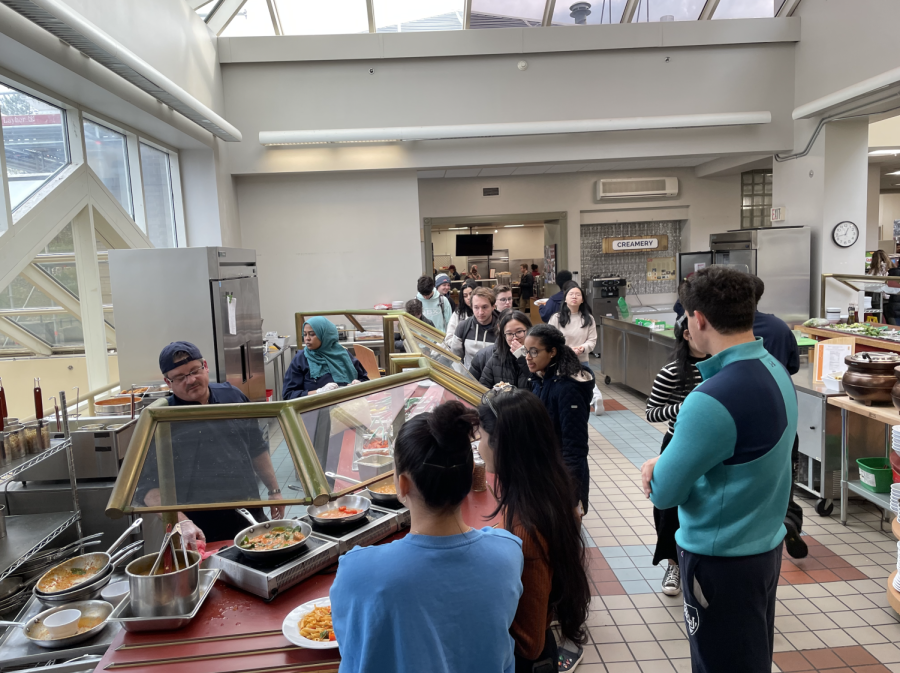More changes to come at Upper dining hall
Students queue for the Pasta Bar in its new place after the renovation.
January 12, 2023
Upper dining hall has been recently reorganized in an attempt to reduce congestion and maximize throughput. This was part of a wider ongoing series of attempts to fix the major issues affecting the dining hall, especially in the critical period of Common Hour, where congestion is the worst. Concordiensis spoke to Tim Forte, Director of Hospitality and Matt Milless, Assistant Vice President for Student Affairs about the steps being taken to reduce the congestion and improve the student dining experience.
The main renovation that was accomplished over the winter break was a shift in the location of the Pasta Bar further into Upper, significantly reducing congestion in the main artery of the dining hall and allowing for a more efficient use of the space. This move has had a pronounced psychological effect, allowing for students to bypass long lines and quickly view more options rather than be bottlenecked near the register. Previous attempts to reduce congestion included the use of stanchions near the Pasta Bar to reduce crowding near the register.
Hospitality still confronts several major issues with moving students into the dining space. The main bottleneck is still swiping at the front of <pg>
the house, the one place where every person wanting to eat at Upper has to pass. The next phase of modifications to Upper will likely be centered around finding solutions to that particular problem.
What has changed?
The move of the Pasta Bar is the attempt to move the most popular stations at Upper to the center of the dining hall. Forte described the process of moving the station as a game of Tetris, trying to fit each piece into the best possible place. This has moved people deeper into the dining room.
The Pasta Bar is not the only station that has moved. Elements, Upper’s station with allergen-free meals and ingredients has incorporated the smoothie station, making it easier to access smoothies from the register, but placing them farther away from seating. Fresh fruit is now available all day as well. Meanwhile, the locations of desserts has been shifted and students may notice that cakes and pie are prepared now in the center.
The renovation has not, however, seen the new introduction of equipment. The equipment that was there in past terms is still there. There are no new heat lamps, fridges, etc. Every piece of equipment that you can see is simply reconfigured.
What’s likely to change?
The change to the stations originated as a combined effort from student interest and Hospitality. Student Forum’s Dining Advisory Council was consulted on what could be done to reduce wait times with an emphasis on reducing wait times at the Pasta Bar and to swipe into Upper at all. This renovation is an iteration of this plan, with more ideas and developments to follow should the members of Student Forum, themselves both administrations and consumers in this endeavor, request further changes. Hospitality and the Dining Advisory Council are expected to meet later this month to discuss further changes.
Student Forum and Hospitality are not the only sources of change in this story. Last term’s survey from Hospitality, as well as more direct outreach, including Hospitality’s social media accounts, comment cards, and the new “Text a Manager” functionality are all designed to increase the amount of feedback received from students and then turn requests into actionable things that can be done.

But the name of the game is still ‘congestion.’ And the way that Hospitality is attempting to remedy this by increasing throughput in as many places as is feasible. One way this is being pushed is to make meals “composed plates.” That is, meals that defy the buffet style that has existed for the entree station, Homestyle, for a long time. This also means lighter lunches. Says Forte, “We want lunch to feel like lunch…we don’t want these heavy entrees and sides that are going to put you in a coma for your second half of the day. We want something that is light and portable and fun and authentic.”
The hope is to move people past the more popular stations quicker by allowing them to simply grab and go. Another part of that is enhancing the information that students have before they enter lines. This has already been accomplished to a limited extent through the refurbishment of the Hospitality website, which is now more active in maintaining an active menu. The same information is also provided on Hospitality’s social media accounts. The digital board that currently displays the “Text a Manager” QR code will in time display the day’s menu. Forte hopes that several boards, scattered around Reamer will give students a better idea of their options before stepping on line.
But it’s possible that the issue of congestion may solve itself over the course of the term. Forte and Milless expect that the long lines at peak times will not be so long in two to three weeks. Says Milless, “We see our highest capacity in the first two weeks, [students] have just come back. They won’t admit it, but sometimes students miss eating in the dining hall…then we see more declining get used later…So it does break a little bit once you get past those first two weeks.”
The hope is that the main bottleneck, the register, can also increase its throughput. By creating multiple parallel queues, lines can be shortened and students can move through that area faster. There was even a proposal of several self-swipe points, but this remains an aspiration for the time being.
What are the limitations?
The major challenge to congestion is the primacy of Reamer as the central food destination. During common hour, the building is the center of a deluge of students, staff, and faculty. First-year students are expected to still have access to Upper, although according to Forte and Milless the ball is really in Student Forum’s corner on that issue. However, drawing more students to eat at West instead of Upper remains an aspiration, but one with no clear solutions.








